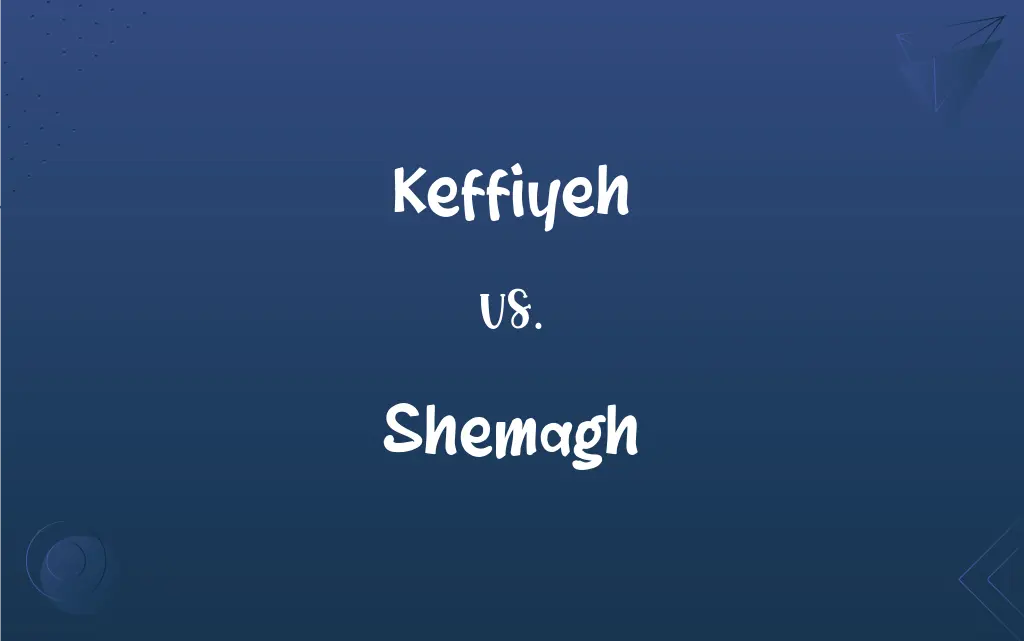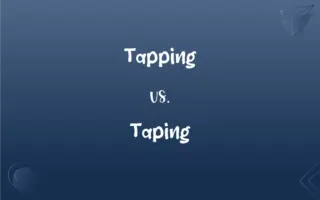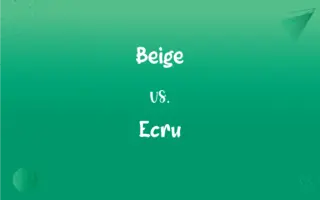Keffiyeh vs. Shemagh: What's the Difference?
By Aimie Carlson & Harlon Moss || Updated on March 3, 2024
The keffiyeh is a traditional Middle Eastern headscarf known for its checkered pattern, symbolizing Palestinian heritage. The shemagh, often similar to Keffish , is used broadly in arid regions for protection against sun, dust, and sand.

Key Differences
The keffiyeh is deeply rooted in Middle Eastern culture, particularly within Palestinian society, where it's more than a headscarf but a symbol of identity and resistance. Traditionally, it features a black-and-white or red-and-white checkered pattern and is worn for both practical and ceremonial purposes. On the other hand, the shemagh is a versatile piece of cloth used across various arid regions of the Middle East and beyond. It serves a practical purpose by providing protection from the harsh sun, wind, dust, and sand. While it may share similarities in design with the keffiyeh, its use is more generalized and not specifically tied to any single cultural or political identity.
The keffiyeh is often made from cotton, making it suitable for the region's hot climate by providing breathability and protection. It's commonly adorned with tassels along the edges and is draped over the head and shoulders in various styles. In contrast, the shemagh is also typically made from cotton or a cotton blend, offering similar benefits in terms of protection and comfort. However, the shemagh is sometimes used in military contexts, especially by Western forces in the Middle East, for its practicality in desert environments.
Historically, the keffiyeh gained international recognition as a symbol of Palestinian nationalism during the 20th century, particularly associated with figures such as Yasser Arafat. It has since been adopted by various groups worldwide as a symbol of solidarity with the Palestinian cause. Meanwhile, the shemagh has been utilized by military personnel, adventurers, and travelers in desert regions, appreciated for its functional versatility rather than its symbolic significance.
In recent years, both the keffiyeh and shemagh have found their way into fashion, with variations of these scarves being worn as fashion statements beyond their regions of origin. While the keffiyeh remains a powerful cultural emblem, the shemagh is often viewed through a more utilitarian lens, valued for its practical applications in harsh environments.
Despite their differences, both the keffiyeh and shemagh reflect the rich cultural tapestry of the Middle East and the adaptability of traditional garments in modern contexts. Whether as symbols of identity and resistance or as practical tools for survival in harsh climates, these garments carry with them stories and traditions that transcend their immediate utility.
ADVERTISEMENT
Comparison Chart
Origin
Middle East, particularly Palestine
Middle East, broadly used in arid regions
Symbolism
Palestinian identity and resistance
Generally lacks specific cultural or political symbolism
Material
Typically cotton
Cotton or cotton blend
Design
Checkered pattern, often with tassels
Varied patterns, including checkered
Usage
Cultural garment, symbol of solidarity
Protection against environmental elements, military use
ADVERTISEMENT
Adoption
Nationalistic and cultural contexts
Broad usage in desert environments, military, and fashion
Fashion
Adopted globally as a political statement
Adopted for practicality and style
Practicality
Sun and dust protection, cultural wear
Sun, dust, and sand protection, versatile utility
Keffiyeh and Shemagh Definitions
Keffiyeh
A traditional Palestinian scarf known for its checkered pattern, symbolizing national identity.
The activist wore a keffiyeh at the rally to show solidarity with Palestine.
Shemagh
Commonly used by military personnel for its practicality in desert environments.
The soldiers donned shemaghs to protect against the blowing sand.
Keffiyeh
Worn around the head or shoulders, the keffiyeh offers protection and cultural expression.
He draped the keffiyeh around his neck, embracing both its heritage and practicality.
Shemagh
Shemaghs come in various patterns and colors, serving both functional and fashion purposes.
Her vibrant shemagh stood out, a fashionable nod to its practical origins.
Keffiyeh
The keffiyeh's distinct patterns and colors can signify different Palestinian regions.
The black-and-white keffiyeh he wore represented his family's origins in Jerusalem.
Shemagh
Its utility and adaptability have made the shemagh popular among adventurers and travelers.
Equipped with a shemagh, the explorer set out into the Sahara, prepared for the harsh conditions.
Keffiyeh
Often made from cotton, the keffiyeh is suited for the hot, sunny climate of the Middle East.
The breathable cotton keffiyeh provided relief from the desert sun.
Shemagh
A versatile scarf used in arid regions for protection against the sun, dust, and sand.
The traveler wrapped a shemagh around his face to shield against the desert storm.
Keffiyeh
The keffiyeh has been adopted globally as a symbol of resistance and solidarity.
At the international conference, delegates wore keffiyehs to support Palestinian rights.
Shemagh
The shemagh can be styled in various ways to cover the head and face.
He expertly tied the shemagh, covering his head and mouth, leaving only his eyes visible.
Keffiyeh
A square of cloth, often embroidered, traditionally worn as a headdress by Arab men, either by winding it around the head or by folding it into a triangle, draping it over the head, and securing it with an agal. Also called shemagh.
Shemagh
See keffiyeh.
Keffiyeh
A headdress traditionally worn by some Arabs, also used as a scarf.
Shemagh
A headcloth designed for a desert environment to protect the wearer from sand and heat.
FAQs
How do you properly wear a keffiyeh or shemagh?
Both can be worn in various styles, typically folded into a triangle and wrapped around the head and neck, with adjustments for coverage and comfort.
What do the colors and patterns on a keffiyeh represent?
The colors and patterns on a keffiyeh can represent different Palestinian regions or factions, with black-and-white and red-and-white being the most recognized.
Is it culturally appropriate for non-Arabs to wear a keffiyeh or shemagh?
While they are widely adopted in fashion, wearing a keffiyeh, given its political symbolism, should be done with understanding and respect for its cultural significance.
What is the historical significance of the keffiyeh?
The keffiyeh holds historical significance as a symbol of Palestinian identity and resistance, particularly associated with the struggle for national rights.
Are keffiyehs and shemaghs only for men?
No, both keffiyehs and shemaghs are worn by people of all genders, serving both practical and fashion purposes.
What materials are used to make a keffiyeh or shemagh?
They are typically made from cotton or a cotton blend, chosen for its breathability and suitability in hot, arid climates.
Can the keffiyeh and shemagh be used interchangeably?
While they can be used interchangeably for practical purposes, the keffiyeh carries specific cultural and political symbolism that the shemagh generally does not.
How do you clean and maintain a keffiyeh or shemagh?
They should be hand-washed or machine-washed gently in cold water with mild detergent and air-dried to maintain their fabric and color integrity.
What is the difference between a keffiyeh and a ghutrah?
A ghutrah, also known as a "gutra" or "kufiya," is similar to a keffiyeh but is typically worn in Gulf countries and is often plain white or checkered without the symbolic significance of the keffiyeh.
Are there specific occasions when wearing a keffiyeh is more appropriate?
The keffiyeh is often worn during cultural celebrations, political events, or demonstrations as a symbol of Palestinian identity, but it is also worn daily for practical purposes.
How is the shemagh used in military contexts?
In military contexts, the shemagh is used for protection against sun, wind, and sand, and it can also serve as a makeshift camouflage or bandage.
Can wearing a shemagh prevent heatstroke in desert conditions?
Yes, a shemagh can help prevent heatstroke by shielding the head and neck from direct sunlight, reducing the risk of overheating.
Why has the shemagh become popular in outdoor and survivalist communities?
Its durability, versatility in use for protection, and utility in emergency situations make the shemagh popular among outdoor enthusiasts and survivalists.
What are the ethical considerations when purchasing a keffiyeh?
Ethical considerations include supporting Palestinian artisans and businesses to ensure that the purchase respects and contributes to the preservation of cultural heritage.
How has the fashion industry impacted the traditional use of the keffiyeh?
The fashion industry's adoption of the keffiyeh has brought it global recognition but has also sparked debates about cultural appropriation and the dilution of its symbolic value.
What does the increasing global popularity of the keffiyeh signify culturally?
Its global popularity signifies a growing awareness and solidarity with Palestinian issues, though it also raises questions about cultural appropriation.
Is there a specific way to fold a shemagh for optimal protection?
Folding a shemagh starts with a square fold into a triangle; the way it's wrapped around the head and face can be adjusted for optimal protection from the elements.
How has the symbolism of the keffiyeh evolved over time?
Originally a marker of Palestinian identity, the keffiyeh has evolved into a broader symbol of resistance, solidarity, and social justice movements worldwide.
Can the shemagh be considered a versatile survival tool?
Yes, beyond its use as headwear, the shemagh can serve various survival functions, such as a makeshift sling, bandage, water filter, or protection from smoke and dust.
How do different cultures within the Middle East view the keffiyeh and shemagh?
While the keffiyeh is specifically associated with Palestinian identity in some areas, both garments are generally regarded across the Middle East as practical and traditional headwear, with variations in style and significance.
About Author
Written by
Aimie CarlsonAimie Carlson, holding a master's degree in English literature, is a fervent English language enthusiast. She lends her writing talents to Difference Wiki, a prominent website that specializes in comparisons, offering readers insightful analyses that both captivate and inform.
Co-written by
Harlon MossHarlon is a seasoned quality moderator and accomplished content writer for Difference Wiki. An alumnus of the prestigious University of California, he earned his degree in Computer Science. Leveraging his academic background, Harlon brings a meticulous and informed perspective to his work, ensuring content accuracy and excellence.
































































